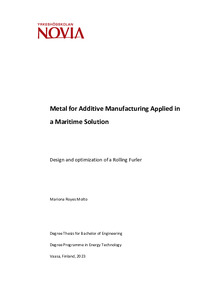Metal for Additive Manufacturing Applied in a Maritime Solution: design and optimization of a Rolling Furler
Royes Molto, Mariona (2023)
Royes Molto, Mariona
2023
All rights reserved. This publication is copyrighted. You may download, display and print it for Your own personal use. Commercial use is prohibited.
Julkaisun pysyvä osoite on
https://urn.fi/URN:NBN:fi:amk-2023060923117
https://urn.fi/URN:NBN:fi:amk-2023060923117
Tiivistelmä
Additive manufacturing (AM) is an innovative manufacturing process, which is still in the process of research and expansion in the business sector due to its high costs. This thesis aims to design and optimise a rolling furler benefitting from the additive manufacturing process and a swivel carbine, used for climbing, to reduce its complexity and its cost.
The design consisted in taking advantage of Design for Additive Manufacturing (DfAM). Specifically, two optimization methods for reducing redundant material have been employed in this thesis, lattice structures and topology optimization. Additionally, the redesign of the different components has also been considered the need to merge some parts to reduce the printing process and minimise the material used. This has been achieved by reducing the initial number of components from 7 to 5.
These optimizations reduced the weight of the final prototype by 39,22% with respect to its initial model, with a final weight of 471 g. Also, an economic analysis was conducted, determining a final cost estimation for the Stainless Steel printing for the rolling furler of 977,60€. Nevertheless, in further studies, the economic feasibility of the prototype could be extended by determining a commercialization plan for large-scale production.
The printed components were manufactured in PrintSharp 250 by Prima Additive in Stainless Steel 316L. And as a result, the designed rolling furler is ready to be finished printed and tested on a conventional boat. However, before testing it in a sailboat, further mechanical tests should be conducted to determine its mechanical properties and behaviour under different stresses.
The design consisted in taking advantage of Design for Additive Manufacturing (DfAM). Specifically, two optimization methods for reducing redundant material have been employed in this thesis, lattice structures and topology optimization. Additionally, the redesign of the different components has also been considered the need to merge some parts to reduce the printing process and minimise the material used. This has been achieved by reducing the initial number of components from 7 to 5.
These optimizations reduced the weight of the final prototype by 39,22% with respect to its initial model, with a final weight of 471 g. Also, an economic analysis was conducted, determining a final cost estimation for the Stainless Steel printing for the rolling furler of 977,60€. Nevertheless, in further studies, the economic feasibility of the prototype could be extended by determining a commercialization plan for large-scale production.
The printed components were manufactured in PrintSharp 250 by Prima Additive in Stainless Steel 316L. And as a result, the designed rolling furler is ready to be finished printed and tested on a conventional boat. However, before testing it in a sailboat, further mechanical tests should be conducted to determine its mechanical properties and behaviour under different stresses.
